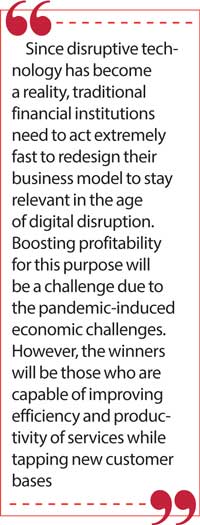Friday Oct 17, 2025
Friday Oct 17, 2025
Tuesday, 10 August 2021 02:13 - - {{hitsCtrl.values.hits}}

Virtual and online banking have attracted heightened attention from the modern business world amidst the current pandemic
 In an interview with the AT&T Tech Channel, in 1976, Sir Arthur C. Clarke had predicted the following. “We are going to get a device which will enable us to send much more information to our friends…. you can call in through this any information you might want; airline flights, the price of things at the supermarket, books you have always wanted to read, news you have selectively chosen…”
In an interview with the AT&T Tech Channel, in 1976, Sir Arthur C. Clarke had predicted the following. “We are going to get a device which will enable us to send much more information to our friends…. you can call in through this any information you might want; airline flights, the price of things at the supermarket, books you have always wanted to read, news you have selectively chosen…”
The abovementioned prophecy has already become a reality. In this day and age, we find it is extremely difficult to survive without our mobile phones. While the rapid advancement of digitalisation is influencing almost all aspects of our lives, the COVID-19 pandemic has accelerated the pace of change. We have been compelled to convert most of our day-to-day activities to a virtual format. Banking is no exception. Virtual and online banking have attracted heightened attention from the modern business world amidst the current pandemic.
A report by McKinsey & Company has revealed that across diverse global markets between 15% and 45% of consumers plan to cut back on branch visits after the end of the pandemic. As observed in a study by Moody’s, there are four drivers which will determine the future position of banks. Ability to adapt to shifting customer expectations, increased competition emanating from advanced technology, potential to manage infrastructure and cost and using technology are the key elements.
It has, therefore, become necessary for traditional financial institutions to make investments in technological infrastructure to stay relevant in the context of rapid digital transformation. This article focuses on the salient features of the world’s virtual banking landscape while drawing strategic imperatives for the Sri Lankan financial system.
Nature of virtual banking
Virtual banking takes place when providing banking services to customers via information technology platforms without requiring them to visit a physical bank branch. This is now called remote banking, online banking, phone banking, neo banking as well as internet banking. Customers can pay bills online, check their bank account balances, transfer money, withdraw and deposit money and checks and obtain loans as well through these online banking channels. However, there is a difference between ‘online banking’ and ‘virtual banking’.
When a traditional bank provides aforementioned services based on an internet platform, it can be recognised as online banking. The special nature of virtual banking is that there is no involvement at all with any regular brick-and-mortar branches. All end-to-end transactions in a virtual bank take place in digital mode. According to the definition adopted by the Bank Negara Malaysia, a banking business carried on primarily or wholly through digital or electronic means is considered virtual banking. A bank that primarily delivers retail banking services through the internet or other forms of electronic channels instead of physical branches is identified as a virtual bank by the Hong Kong Monetary Authority (HKMA).
 Pros, cons and lessons to learn
Pros, cons and lessons to learn
From the starting point i.e., opening of an account in a virtual bank, the priority has been attached to the convenience and speed. All you need is a smart mobile device and your identification documents required for account opening can be submitted via the relevant app. One may argue that digital onboarding of customers can lead to usage of fake or forged documents. However, if the access to official databases of personal identification is available to banks subject to robust data protection laws, such concerns can be addressed.
Digital customer onboarding needs to be in compliance with Anti Money Laundering and Terrorist Financing regulations. They should also be within the ‘enhanced customer due diligence’ parameters. Technological infrastructure in virtual banks should be robust enough to detect fraudulent acts.
This convenience coupled with speed in virtual banking have been identified as factors which attract new customers to the banking territory from the unbanked segments. It will enhance financial inclusion of a country which is a key imperative in inclusive economic development. Availability of access to account and banking information around the clock and lower charges and fees due to operational cost efficiency are among other advantages of virtual banking.
Virtual banks pay higher interest rates than traditional banks. By imposing a relatively low threshold as the approved limit of cash deposits, the possible misuse of virtual bank accounts for money laundering purposes can be mitigated. Promoting the use of debit cards issued against a virtual bank account for day today expenses will also promote a less cash society. Valuable time of people can be saved by using virtual banking without queuing up in a bank branch to execute simple transactions. It will also be a lifesaving factor during a health crisis like the one we are experiencing at this moment.
The inherent disadvantages of virtual banking are the security threats associated with IT platforms. Regulatory authorities can mitigate this risk by ensuring the relevant bank has invested in secured and sophisticated technological infrastructure required for protected transactions. The lack of face-to-face relationships to clarify issues is also seen as a weak point in the virtual banking experience. If the ‘pay points’ to deposit and withdraw money are not easily available, it may also hamper the convenience of customers.
International virtual banking experience
Organisations, which were established in the 1990s like Japan Net Bank and Manulife Bank in Canada, have set an example of sustainability and proven business models for other new virtual banks to emulate. Several Asia Pacific countries have also issued policy papers pertaining to virtual banking regulatory precepts. Virtual banks are operating in the USA, UK, China and Russia as well. In Hong Kong, incumbent banks have progressively embraced fintech companies to provide multifaceted financial services.
This has served to bring together the customer bases of banks and the advance technology provided by fintech companies to improve financial intermediation and increase inclusion. In 2017 the HKMA announced the plan to bring the country into a ‘New Era of Smart Banking’. As a result of this project, the HKMA has granted eight licenses to virtual banks. The licensing procedure leads to narrow the regulatory arbitrage that may be available to non-bank fin tech companies.
The requirement to have a head office of the virtual bank, in Hong Kong, to address inquiries and related issues serves to preserve public trust in their operations. Moreover, the high capital requirement, identification of a robust business model and the need to comply with the same regulatory standards as physical banks have resulted in the streamlining and stabilising of the virtual banking landscape, in Hong Kong. Ensuring that carefully designed exit plans are available for virtual banks is also a vital element.
The HKMA requires the virtual banks to have plans in place which include trigger points for exit and a repayment mechanism to customers and the sources of funding as well. The supervision framework for virtual banks has also been designed in terms of a risk-based policy.
In the UK also, authorisation obtained from the Financial Conduct Authority, a banking license issued by the Prudential Regulation Authority and compliance with capital requirements are essential prerequisites for virtual banking operations. The ‘regulatory nursery’ concept, introduced by the Financial Conduct Authority of the UK, helps in implementing a balancing act between innovative financial products and consumer protection.
Under the concept of the ‘regulatory nursery’, close contact is kept with firms immediately post-authorisation to provide support and intervene when it is necessary to steer the relevant firms in the right direction. Close interaction of this nature between the industry and the regulator creates a mutually reinforcing environment for both parties.
According to the S&P Global, four factors namely, the current state of technology, regulation, industry and customer preferences need to be assessed in evaluating the risk of tech disruption in each individual banking sector. Sri Lanka’s preparedness to withstand evolving disruptive technologies in the financial sector can also be measured by using these assessment factors.
Strategic imperatives to stay relevant in the digital transformation
The financial regulatory regime of Sri Lanka too will have to be equipped with the required knowledge and regulatory tools to embrace these new chapters of digital transformation. Most importantly, the International Financial Centre to be launched in the Port City, Sri Lanka, will underscore the need for regulatory readiness to evolve with market developments in this digitalised era. However, it would be prudent to improve the online banking eco system in Sri Lanka, prior to leapfrogging towards virtual banking. Improving the online banking space can be linked up with national financial inclusion agenda as well.
The advantage of the lower overhead costs of online platforms can be passed on to the people at the bottom of the social pyramid and SMEs by way of small and inexpensive loans. Incumbent banks can leverage their online banking platforms for this purpose.
Rising customer expectation in the context of evolving technological improvements is another key challenge that needs to be addressed by financial institutions in Sri Lanka. Studies reveal that enhanced online services available to the fintech industry will break banks’ heavy gravitational pull-on customers. When customers expect multidisciplinary functionality from banks and want them to be ‘one stop shops,’ incumbent traditional banks will need more resources to meet such expectations.
Making seamless services available on customers’ digital devices, while exercising due diligence, has already become a key challenge during the current pandemic situation. Traditional banks, which have already built-up digital infrastructure, can leverage their position to innovate new products for advanced customers, focusing on stable revenues. Since online banking is usually focused on simple retail products, large banks can expand the boundary of their product space through such innovations.
Public trust in the traditional banks can be capitalised upon in accelerating the product innovation trajectory. Improving business packages available for SMEs by including suggestions related to their HR and fund management and harnessing the quality of the projects will also bring positive outcomes. Existing technical infrastructure will be adequate to go that extra mile provided the management of financial institutions has right attitude to connect with customers.
In addition to the poor risk governance and mismanagement of the respective entities, recurrent failures of non-bank financial institutions are reported from the Sri Lankan financial system due to too many institutions competing for the same small market. In tandem with consolidation in the financial system, it would be prudent to promote online banking opportunities for the unbanked/underbanked populations in the country through these finance companies. These entities will have to have a renewed focus on new sustainable corporate branding in launching such product packages customised for underserved segments in society.
Harnessing online banking platforms, in Sri Lanka, should also be done whilst ensuring that carefully devised cyber security and recovery plans are available to the relevant financial institutions. Incumbent financial institutions will be required to make investments in Artificial Intelligence (AI) at least in terms of a phased-out plan. McKinsey & Company reveals that banks that fail to make AI central to their core strategy and operations will risk being overtaken by competition and deserted by their customers.
Research studies have revealed that customers prefer biometrics over passwords for validating payments. Acquiring necessary technology to offer biometric authentication for remote transactions, subject to risk mitigation measures, will also be a requirement for the journey of the Sri Lanka’s financial industry towards digitalisation.
Efficient and effective collaboration with rivals will be another strategic measure. Fintech firms can contribute to enhance competition in the financial services industry. They can also improve efficiency and bring new players to the market. Although the resilient incumbents can withstand the competition emanating from fintech firms, small financial entities can become the casualties. When Fintech firms invade the space of incumbent banks, there will be increased competition. It will eventually result in small banks and finance companies, which are struggling to invest in advanced technology, exiting the market.
Partnering with these startups, acquiring them and improving internal technological development will be a survival strategy for such small entities. However, partnering with fintech companies needs to be curated very carefully. This collaboration between incumbent banks and fintech firms has occurred widely in other jurisdictions.
Digital financial services can be improved to make worker remittance inflows more cost-effective and secure. Fintech platforms, partnered with banks, can be introduced to divert huge volumes of remittances currently routed through informal channels, to the banking sector. The M-Pesa scheme, launched in Africa, is an example of such a holistic mechanism. The branch network of incumbent financial institutions can be used to implement transparent, secure and low-cost remittance services through introduction of digital platforms.
The ability to receive remittances directly into a mobile money account will address the cultural barriers which continue to hamper engaging with the informal sector among certain communities. Providing an appropriate digital solution for migrant workers for sending money home in a cheaper and safer manner will be a real game changer in enhancing foreign exchange inflows to the country. It needs to be launched as a cohesive and comprehensive national program instead of a patchy haphazard policy.
Boards of directors of incumbent financial institutions will need adequate knowledge about IT infrastructure for implementing improved digital services. Boards of directors, management and all employees of these institutions should be flexible and agile to move along with evolving market innovations. They need to be educated and well-trained to perform in a technologically advanced and highly competitive industry. Building in-house expertise to make necessary adjustments to core systems, as and when necessary, will also be a positive factor in the long run.
Along with the commercialisation of business strategies and making investments in digital infrastructure, cultivating the right corporate culture, which supports the relevant financial institution’s navigation through challenges, is very vital. Experimenting with the continuation of hybrid working models commenced during pandemic and investing in skilled staff will also be among proactive approaches for managing the change under reference.
Gaps in the financial literacy level of the general public need to be addressed to enable them to obtain the maximum benefits of digital banking services. The high literacy level and mobile phone penetration, in Sri Lanka, can be used to create a conducive business environment for fostering digital financial services. Conducting more public awareness campaigns about the benefits of virtual/online banking and the precautionary measures to be followed to avoid potential pitfalls also need to be given priority.
The path ahead
Since disruptive technology has become a reality, traditional financial institutions need to act extremely fast to redesign their business model to stay relevant in the age of digital disruption. Boosting profitability for this purpose will be a challenge due to the pandemic-induced economic challenges. However, the winners will be those who are capable of improving efficiency and productivity of services while tapping new customer bases.
Revisiting the legacy systems to identify non-productive areas will also be a step towards strengthening resilience and fostering a customer-centric culture in financial institutions. While adopting an agile regulatory policy towards digital financial services, it would be advisable to devise a measured agenda towards virtual banking. With the Big Techs making inroads into the financial services industry, competition for incumbent banks in any jurisdiction will be an inevitable outcome. Taking measures to be future-ready institutions will, therefore, not be a waste of time.
Maintaining close collaboration between the financial industry and the regulatory authorities will be important in integrating new technologies while mitigating associated risks. In this journey towards digital banking, it is important to ensure that the vulnerable segments are not left behind. People who cannot afford to buy mobile devices and who find it is difficult to engage in online banking will still need to carry out cash transactions and visit physical bank branches.
Re-writing institutional purposes of financial institutions so that they are not confined solely to the profit maximisation goal and become strategic partners in the country’s inclusive development agenda is also a significant objective. Bank branches, equipped with modern digital infrastructure and staff which possess the unique Sri Lankan hospitability qualities, will be the right blend for writing a new legacy in the brisk transformation towards digitalisation. This unique physical-digital combination can be capitalised upon by Sri Lankan financial institutions to remain competitive in the disruptive digital race.
“We are witnessing the creative destruction of financial services, rearranging itself around the consumer. Who does this the most relevant, exciting way using data and digital, wins” – Arvind Sankaran
(The writer, a Deputy Director, CBSL, Attorney-at-Law, can be reached at [email protected]. The views and opinions expressed in this article are those of the writer and do not necessarily reflect the official policy or position of any institution.)